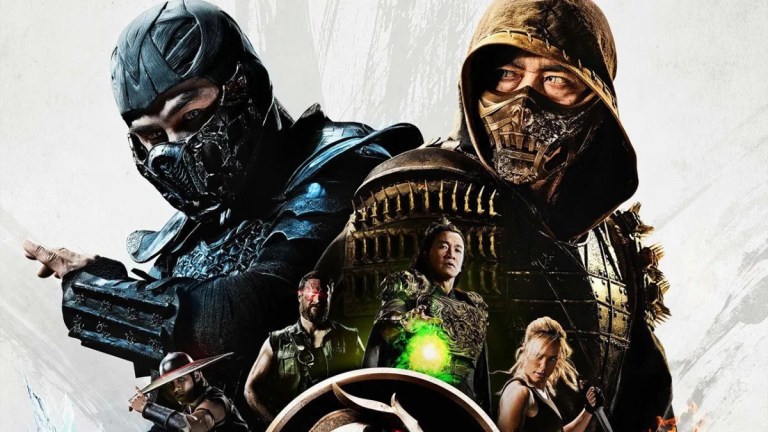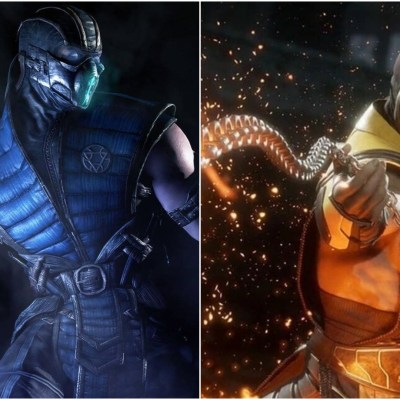Mortal Kombat Easter Eggs and Reference Guide
The new Mortal Kombat movie features many of easter eggs and references to the series' past. Here's what we've found!

This Mortal Kombat article contains spoilers.
There’s a new Mortal Kombat live-action movie out on HBO Max, and it comes after nearly 30 years of games, cartoons, and movie adaptations. With such a long history to pick through, it shouldn’t surprise anyone that the new movie has more than a few easter eggs and references to the series’ most famous moments and characters. Why wouldn’t there be? Why even make a new movie if you’re not going to throw your fans a bone or twenty exploding skulls?
We’re keeping track of all the neat easter eggs that fill the 2021 film, from obscure character references to loving nods to the games’ most gruesome Fatcalities. Here’s what we’ve found so far:
Kombat Jargon
- Cole Young rightfully notes that “Mortal Kombat” is spelled incorrectly. Series creators Ed Boon and John Tobias each have their own explanation for the spelling. Boon claimed that “Combat” was a workshopped name for the game and someone added a K to be weird. Tobias said that the K was there just so they could trademark the term.
- As it’s custom for the Mortal Kombat announcers to say who won each match, Kano takes care of this himself when he kills Reptile and smugly says, “Kano wins.”
- When Kung Lao kills Nitara, he notes, “Flawless victory.” That’s what the announcers say in-game whenever someone has a perfect round. At least it’s used correctly here, unlike the original movie, where people would say, “Flawless victory,” in regards to fights where both sides took blows.
- There are many deaths in the movie, but only Liu Kang announces, “Fatality,” like in the game.
Scorpion and Sub-Zero
- Bi-Han killing Hanzo Hasashi has been depicted many times in Mortal Kombat media, though canonically in the game Mortal Kombat Mythologies: Sub-Zero. The version in this movie more closely resembles the events of the animated film Mortal Kombat Legends: Scorpion’s Revenge. The big difference that sets this movie apart from the others is the fact that Hanzo existed centuries ago and not in the present. That, and the depiction of Sub-Zero as pure evil. While Bi-Han is no saint, his killing of Hanzo is usually depicted as strictly business. In the games, the murder of Scorpion’s family is the doing of Quan Chi, who uses the tragedy to manipulate Scorpion into his service.
- Outside of his feud with Scorpion, Sub-Zero’s villain status in this movie more closely matches the origin of Erron Black, the anachronistic Wild West gunslinger who first showed up in Mortal Kombat X. Centuries ago, Shang Tsung felt threatened by a potential challenger in the Mortal Kombat tournament. He hired Erron Black to assassinate the threat, and in return Tsung would teach Black the secrets to living for thousands of years.
- Scorpion pulls off his classic Toasty Fatality, which also turns his mouth into charred bone. Scorpion’s always had this weird situation going on with his face where sometimes it’s flesh and sometimes it’s just a skull. Here, we get a bit of both!
Sonya Blade and Jackson Briggs
- On Sonya’s research wall, there’s a book excerpt on a Native American tribe called Matokans, focusing on shamans and warriors. The clipping mentions a tribe member known as “the Night wolf.” Nightwolf is a character (and title) introduced in the third game. He strongly resembles the sketch included in the clipping. “Matokan Warrior” is one of his variations in Mortal Kombat 11.
- Also on the wall is a photo of a sculpture of the Mayan God of War, Buluc Chabtan. In Mortal Kombat lore, this is the Outworld warrior Kotal Kahn, who for a time ventured into Earthrealm and was worshipped as a god by the Mayans. The character was introduced in Mortal Kombat X when he took over Outworld in the aftermath of Shao Kahn’s death. While still barbaric, his rule was considered more progressive than his predecessor’s.
- While Sonya’s rings attack is treated as a superpower here, in the games, it’s treated as more of a high-tech wrist weapon.
- The subplot about Sonya’s worth due to her lack of dragon tattoo could be interpreted as a commentary on how the original movie handled Sonya in the third act. Shang Tsung kidnapped her and chose to make her the finalist in the tournament, which everyone treated as a fight Sonya could never win in a million years. The way the original movie turned Sonya into a damnsel in distress annoys many fans to this day.
- The origin of Jax’s metal arms has been told many different ways through the decades. He’s lost them at the hands of Baraka, Ermac, a Special Forces goon, and Goro. This is the first time Sub-Zero has been responsible.
- Jax splattering his opponent’s head with a clap of the hands is a Fatality he’s had since Mortal Kombat II.
Kano and the Black Dragon
- Kano has trouble using the GPS to track Raiden’s temple. This is probably a callback to the original movie, where Shang Tsung’s Island caused Sonya’s compass to go haywire.
- Kano’s face gets clawed up, and later he’s able to shoot a red laser from his eye socket. In the games, Kano has a metal plate over his eye, giving him that laser ability.
- The heart rip was Kano’s Fatality in the first game. He’s since introduced many variations of it.
- The Black Dragon is brought up a few times. A scummier offshoot of the terrorist organization the Red Dragon, Kano’s group has included such characters as Kabal, Jarek, Kira, Kobra, Erron Black, and Tremor.
- Kabal blames Kano for why he’s stuck in his respirator-based costume. In the games, Kabal was a Black Dragon member who left the group and became a cop. During the events of Mortal Kombat 3, Kabal was burned alive by Kintaro. Kano actually saved Kabal and hooked him up to the respirators in hopes of recruiting him. Shang Tsung tried to use magic to heal Kabal’s lungs, which gave him super-speed as a side-effect.
- Kano refers to Raiden as “Gandalf” and considers his comrades’ magical attacks as “Harry Potter shit.” Fitting that Kano’s references keep with properties owned by Warner Bros.
- Kano’s overall story here is a lot like the ’90s comic book Mortal Kombat: Rayden and Kano. In the comic, Rayden (they spelled it differently back then) attempted to hire Kano to help destroy Shao Kahn, as he was the descendant of a hero who liberated Outworld long ago. Kano ultimately betrayed Rayden, just as he betrays his teammates in this movie.
Liu Kang and Kung Lao
- Kano refers to Liu Kang as “MC Hammer” due to their shared love of puffy pants.
- Liu Kang brings up Master Bo’ Rai Cho, a character introduced in Mortal Kombat: Deadly Alliance. Bo’ Rai Cho (a play on “boracho” meaning “drunk” in Spanish) is an Outworld warrior who sympathized with Earthrealm and chose to protect it from Shao Kahn. Being from Outworld, he could not enter Mortal Kombat without it counting against Earthrealm. Instead, he’s dedicated thousands of years to training Shaolin warriors in hopes of one of them winning the tournament and ending Outworld’s streak. He mentored Liu Kang and Kung Lao firsthand.
- Kung Lao mentions being the descendant of the original Kung Lao. The Great Kung Lao was a Shaolin monk who regularly defended Earthrealm in Mortal Kombat. He even defeated Shang Tsung at least once. But his streak came to an end at the hands of Goro. Later games revealed that the modern Kung Lao is a reincarnation of the original.
- Liu Kang is able to get the better of Kano by spamming the leg sweep. This is a reference to a very annoying tactic in the early games.
- The way Kung Lao kills Nitara is similar to his Fatality from Mortal Kombat 9, the difference being that, in the game, the victim is cut apart crotch-first.
- Kung Lao dying to drive Liu Kang’s story forward is a regular trope in Mortal Kombat. Lao’s death first came in Mortal Kombat 3. But in the Mortal Kombat 9 reboot, Kung Lao went on a major winning streak during the retelling of Mortal Kombat II, but then Shao Kahn grabbed him from behind and snapped his neck. Liu Kang reacted by punching a hole through Kahn’s chest.
Raiden’s Temple
- The paintings depict the Great Kung Lao standing over a beaten Shang Tsung. Kung Lao is probably the victim of the painting of Goro tearing a poor guy in half. Other images show Bi-Han murdering Hanzo and the rule of Shao Kahn, the true villain in the Outworld invasion.
- One painting shows Argus and Delia, protectors of the realm Edenia, watching over the prone body of a bearded man with some kind of war going on in a cloud above. This man appears to be one of their sons, either Taven or Daegon. Both were put in a slumber as part of a prophecy/contest to stop Armageddon, an event where so many Mortal Kombat characters were at war that it threatened to destroy reality itself.
- There’s a fan on display belonging to Kitana. Kitana is Shao Kahn’s adopted daughter and brainwashed assassin. She tends to betray Outworld and align herself with Liu Kang. Strangely, while she isn’t in this movie, her clone Mileena is.
Shang Tsung and Outworld
- While Reptile has been around since the first Mortal Kombat game, the design used for the movie is based on Mortal Kombat: Deadly Alliance. Like in the game, Reptile’s abilities include invisibility, an extended tongue, and acid saliva.
- In the games, Nitara first appeared in Mortal Kombat: Deadly Alliance. She’s depicted as a loner and manipulator who wants to bring back her lost vampire realm. A very random choice to be sure, but she also had a cameo in Mortal Kombat Legends: Scorpion’s Revenge, so somebody out there really digs her.
- General Reiko was first introduced in Mortal Kombat 4 as one of Shinnok’s henchmen. He was given an extremely vague ending that had him running into a portal to parts unknown, but certain home ports expanded on it to show him putting on Shao Kahn’s mask, suggesting they were the same person. This was later handwaved away as Reiko just really liking Kahn’s mask and wanting power for himself.
- When Reiko was brought back in Mortal Kombat: Armageddon, he was given the giant warhammer as his weapon stance.
- When killing Kung Lao, Shang Tsung tells him, “Your soul is mine!” That hammy quote was Shang Tsung’s go-to threat in the first movie. Also, eating souls is Tsung’s go-to Fatality in just about any game.
- Goro threatens to tear out Cole’s spine. While that is more of Sub-Zero’s thing, it’s also the iconic Fatality that Mortal Kombat is remembered for. Fellow Shokan warrior Sheeva also has a spine-ripping Fatality in Mortal Kombat 11.
Johnny Cage
- The movie ends with a teaser for Johnny Cage, who will presumably appear in the sequel if that project happens. In the final shot of the movie, we see a cropped image of a movie poster for Citizen Cage, one of Johnny’s many established movies from the game’s lore. The poster shows him wearing his large “CAGE” belt buckle, which was introduced in Mortal Kombat 9. That makes it all the more likely that he’ll have “JOHNNY” tattooed across his chest.
- There’s another movie poster to the side that we can’t see too much of other than it having “Fist” in the title. Going on the games, this could be The Gist of My Fist or Dragon Fist.
Let us know in the comments if we missed anything!


